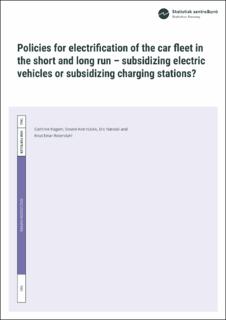Policies for electrification of the car fleet in the short and long run – subsidizing electric vehicles or subsidizing charging stations?
Working paper
Permanent lenke
https://hdl.handle.net/11250/2995393Utgivelsesdato
2022-05Metadata
Vis full innførselSamlinger
- Discussion Papers [1003]
Sammendrag
Abatement can be performed by measures that have an impact on present emissions, but no lasting effect, and by long-lived infrastructure investments. We study the optimal combination of short and long-lived options for reducing greenhouse gas (GHG) emissions, by specifying abatement cost functions depending on abatement from these two options. Electrification of the transport sector is used as an example. A transition from internal combustion engines vehicles (ICEVs) to electric vehicles (EVs) can be incentivized by both subsidies on purchases of EVs and increased density of fast chargers. Subsidizing the purchase of EVs only leads to emissions reductions in the next few years (static option), whereas investment in infrastructure also will reduce abatement costs in several years to come (dynamic option). We find that the present marginal abatement cost of the dynamic alternative exceeds the costs of static abatement in optimum, thus the dynamic option may be profitable even if it is more expensive. A higher expected abatement cost in later periods most likely makes it even more profitable to use the dynamic policy instrument. This framework is used for a numerical study on electrification of the transport sector in Norway. The numerical simulations confirm the results of the theory model. Flexibility in the domestic target over time and the presence of an international permit market affect the combination of static and dynamic abatement. This stresses the importance of early and time consistent plans for international regulations of GHG emissions.

